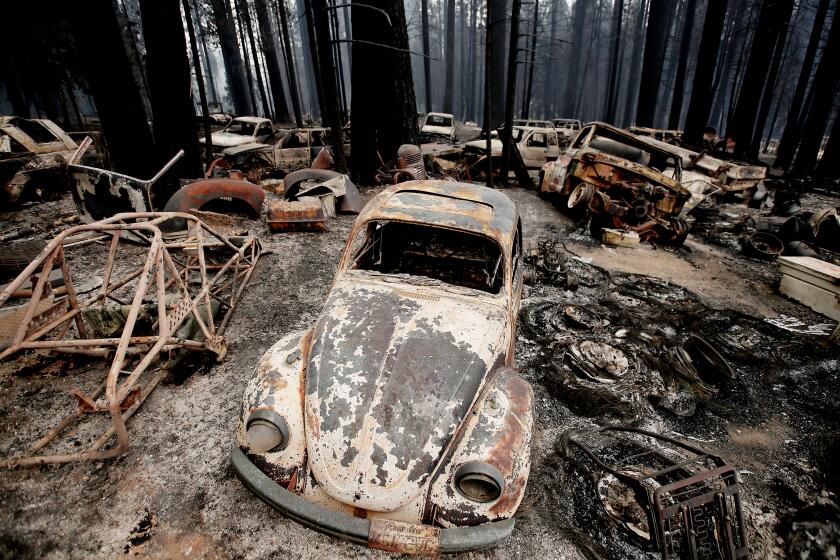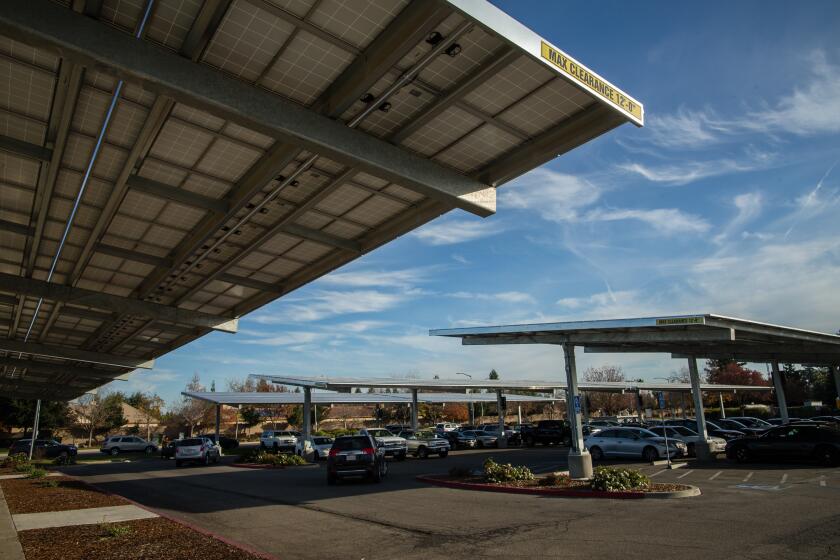California needs to do more than just throw money at climate change. It must act

- Share via
For the second year in a row, California has been blessed with a massive budget surplus, and Gov. Gavin Newsom is again seeking to spend billions of those dollars responding to climate change.
The $22 billion Newsom proposed last week is the largest investment in climate change in state history. Combined with funds from last year’s state climate spending package, it would provide California with a total of $37 billion for climate-related initiatives over a six-year period. The funds would support the switch to zero-emission transportation, including electric cars, trucks, buses and charging infrastructure. There is money to clean the electric grid, prevent wildfires, respond to the drought and protect coastal areas from rising sea levels, build housing in urban cores and help workers transition away from fossil fuel industries, among many other priorities.
Newsom is right to take advantage of this windfall to do more to adapt to the warming climate and push the state toward a carbon-free future, and the Legislature should support his proposal. But allocating money is not enough. We need action from state lawmakers, who have yet to mandate emissions reductions that are fast, steep or broad enough to get California on track to avoid truly catastrophic warming.
Of course, more people are worried about climate change given the escalating wildfires, heat waves and other climate disasters. But you wouldn’t know it from our government’s flagging response.
The last few years have been brutal for Californians, who have experienced a grim parade of climate-fueled disasters, including record-setting wildfires, severe drought, deadly heat waves and air pollution. Newsom administration officials say the size of the spending package shows California’s actions are finally matching the scale of the climate crisis.
“I am excited that we are finally tackling the problem with the magnitude of investment and vision required,” Lauren Sanchez, the governor’s senior climate advisor, told reporters last week.
Tens of billions worth of climate funding sounds like a lot, but in reality that spending will not go very far unless it is backed up with new and more aggressive targets and mandates to slash greenhouse gas emissions and swiftly phase out fossil fuels. This one-time infusion seems designed to counter the increasing recognition that California is not the climate change pioneer it once was. As Assembly Speaker Anthony Rendon lamented to CalMatters during last year’s U.N. climate conference in Glasgow, Scotland, “I don’t at all feel that we are leading the world anymore.”
California is falling behind other states and countries with its outdated climate targets and mandates, and hasn’t passed significant climate legislation in years. Among the biggest obstacles are the so-called moderate Democrats in the Legislature who have acted at the behest of oil and gas interests and organized labor to block climate action.
California won’t be able to meet its targets at its current pace of pollution reduction. Here are three actions state officials can take in the next year to pick up the pace.
Newsom, to his credit, has begun pushing ahead with executive orders and administrative actions to restrict fossil fuels. But he has to do more to persuade lawmakers to break through their unwillingness to act. He should start by clearly articulating a plan and vision not just for spending on climate change, but for legislation that will truly match the scale of the problem and reestablish California as a climate leader. He must follow up these spending priorities with a legislative agenda that puts some muscle behind the money.
As one example, Newsom is proposing nearly $1 billion to replace natural-gas-fueled heating and cooking appliances with electric models, along with other energy efficiency upgrades aimed at low-income communities. But he has set no target date for phasing out the sale of gas furnaces, water heaters, stoves and dryers — as he has for new gas-powered passenger vehicles by 2035. The governor can change that, while putting his support behind legislation to electrify and reduce greenhouse gas emissions from new and existing buildings, bills that either died or failed to move forward last year in the face of opposition from industry and organized labor.
There are many other ways the governor can lead on climate. He can throw his support behind measures to hasten the demise of fossil fuel production, including ambitious legislation being crafted in response to last fall’s oil spill off the Orange County coast to end all drilling in state waters. He can direct the state Air Resources Board to strengthen its proposal for new zero-emission vehicle standards by speeding up the percentage of electric vehicles automakers are required to sell. And Newsom can urge his appointees on the state Public Utilities Commission to pull back an ill-advised proposal to slash incentives for rooftop solar, a plan that he recently acknowledged needs changes.
Priority number one must be ending fossil fuels and the pollution they cause, and California can’t get there just by throwing money at the problem and calling it climate action.
More to Read
A cure for the common opinion
Get thought-provoking perspectives with our weekly newsletter.
You may occasionally receive promotional content from the Los Angeles Times.












